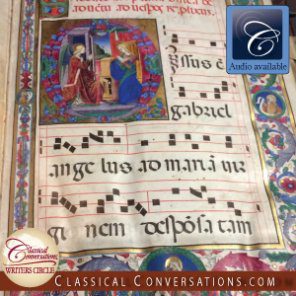On an autumn day in downtown Boston…
I walk into the final, special exhibit in the Isabella Stewart Gardner Museum. It’s called Beyond Words: Italian Renaissance Books. Dim lamps and dark green walls surround glass cases with carefully lighted displays, showing a selection of books that have survived for over five hundred years. Five hundred years! I am six inches away from a first edition printing of Dante’s Inferno. There is a solemn hush among the visitors.
One entire wall is devoted to choir books from the medieval church. The books are enormous, each page the height of my arm in order to make the words and music visible to the entire choir. The illustrations on the parchment pages are painstakingly done in tempera paint with real gold leaf embellishments. The craftsmanship is stunning and the sense of history is palpable.
Meanwhile, on the other side of the city…
“Ashes, ashes, we all fall DOWN!”
Two tousled blond boys tumble to the Cheerio-spotted carpet, pause, scramble to their feet, and begin again, gulping breaths between words as they gallop around the living room:
“Ring-a-round the rosie,
A pocket full of posies—”
This routine goes on for twenty minutes while their proud auntie watches. It’s not Beethoven by any stretch of the imagination, nor is it a medieval hymn. It might even be a song about the black plague. (No one really knows.) They might wonder some day what the words of this folk song mean. They might not. That’s okay, too. Right now, they’re just having fun mimicking the words their aunt taught them and expending their little boy energy. Nonetheless, I can see a connection between these wisps of song and that enormous book of liturgy in the museum, and it brings a smile to my face.
If I’m honest, I want education to look like those medieval choir books. I want the gold leaf and hand-drawn illuminations and Gregorian chants. But it doesn’t always look like that. Sometimes it’s shouted; sometimes it’s Cheerios on the carpet and crayon scribbles on the wall. And you know what? Both of these scenarios are classical education in action: there is memory and language (grammar); there is interpretation and clash (dialectic); there is beauty and presentation (rhetoric). Both are worthwhile. Moreover, if you ask the classical educators and homeschooling parents you most admire, I bet they’ll tell you that their lives have contained a fair measure of both.
This season, let’s celebrate the whole journey, in all its beautiful phases, not just the ones decorated with gold.
***
Do you live in the Boston area? The Beyond Words exhibit will be on display until January 16, 2017.Visit https://www.gardnermuseum.org/ to learn more.




